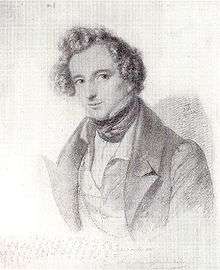Symphony No. 4 (Mendelssohn)
The Symphony No. 4 in A major, Op. 90, commonly known as the Italian,[1] is an orchestral symphony written by German composer Felix Mendelssohn.
| Symphony No. 4 in A major | |
|---|---|
| Italian | |
| by Felix Mendelssohn | |
 Drawing of the composer by Eduard Bendemann, 1833 | |
| Key | A major |
| Catalogue | Op. 90 |
| Composed | 1833, revised 1834 |
| Performed | 13 May 1833 |
| Published | 1851 |
| Movements | four |
History
The work has its origins (as had the composer's Scottish 3rd Symphony and The Hebrides overture) in the tour of Europe which occupied Mendelssohn from 1829 to 1831. Its inspiration is the colour and atmosphere of Italy, where Mendelssohn made sketches but left the work incomplete. Below is a snippet of a letter he wrote to his father:
This is Italy! And now has begun what I have always thought... to be the supreme joy in life. And I am loving it. Today was so rich that now, in the evening, I must collect myself a little, and so I am writing to you to thank you, dear parents, for having given me all this happiness.[2]
In February he wrote from Rome to his sister Fanny,
The Italian symphony is making great progress. It will be the jolliest piece I have ever done, especially the last movement. I have not found anything for the slow movement yet, and I think that I will save that for Naples.
The Italian Symphony was finished in Berlin on 13 March 1833, in response to an invitation for a symphony from the London (now Royal) Philharmonic Society; he conducted the first performance himself in London on 13 May 1833 at a London Philharmonic Society concert. The symphony's success, and Mendelssohn's popularity, influenced the course of British music for the rest of the century.[3] The Germania Musical Society of Boston gave the first performance in the United States, on 1 November 1851, with Carl Bergmann conducting.[4]
Mendelssohn himself, however, remained dissatisfied with the composition, which cost him, he said, some of the bitterest moments of his career; he revised it in 1834[5] and even planned to write alternative versions of the second, third, and fourth movements. He never published the symphony, and it appeared in print only in 1851;[6] thus it is numbered as his "Symphony No. 4", even though it was in fact the third he composed.
Structure
The symphony is scored for 2 flutes, 2 oboes, 2 clarinets, 2 bassoons, 2 horns, 2 trumpets, timpani and strings. It is in four movements:
- Allegro vivace (A major)
- Andante con moto (D minor)
- Con moto moderato (A major)
- Presto and Finale: Saltarello (A minor)
The joyful first movement, in sonata form, is followed by an impression in the subdominant minor of D minor of a religious procession the composer witnessed in Naples. The third movement is a minuet in which French horns are introduced in the trio, while the final movement (which is in the minor key throughout) incorporates dance figurations from the Roman saltarello and the Neapolitan tarantella. It is among the first large multi-movement works to begin in a major key and end in the tonic minor, another example being Brahms's first piano trio.
A typical performance lasts about half an hour.
Notes
- The title is Mendelssohn's.
- Mendelssohn to Abraham Mendelssohn, from Venice, 10 October 1830.
- Programme notes, Susan Halpern
- "San Francisco Symphony – Mendelssohn: Symphony No. 4 in A major, Opus 90, Italian". Sfsymphony.org. Retrieved 26 November 2015.
- J. Michael Allsen, Programme notes, 2008
- In its 1834 revision, and perhaps lightly edited by his friend Ignaz Moscheles (Allsen, Halpern).
External links
- Symphony No. 4: Scores at the International Music Score Library Project (IMSLP)